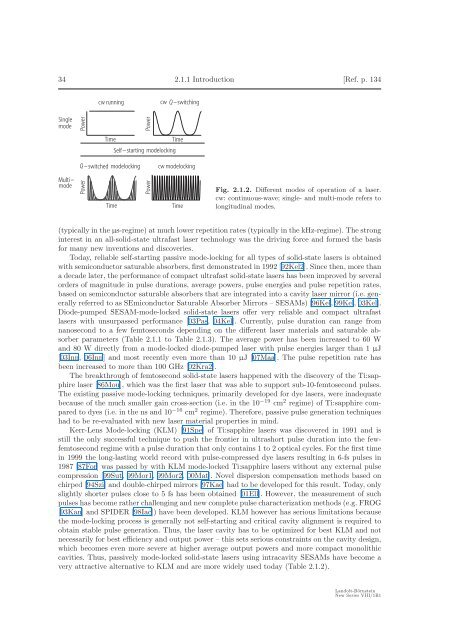2.1 Ultrafast solid-state lasers - ETH - the Keller Group
2.1 Ultrafast solid-state lasers - ETH - the Keller Group
2.1 Ultrafast solid-state lasers - ETH - the Keller Group
You also want an ePaper? Increase the reach of your titles
YUMPU automatically turns print PDFs into web optimized ePapers that Google loves.
34 <strong>2.1</strong>.1 Introduction [Ref. p. 134<br />
cw running<br />
cw Qswitching<br />
Single<br />
mode<br />
Power<br />
Power<br />
Time<br />
Time<br />
Selfstarting modelocking<br />
Qswitched<br />
modelocking<br />
cw modelocking<br />
Multi<br />
mode <br />
Power<br />
Time<br />
Power<br />
Time<br />
Fig. <strong>2.1</strong>.2. Different modes of operation of a laser.<br />
cw: continuous-wave; single- and multi-mode refers to<br />
longitudinal modes.<br />
(typically in <strong>the</strong> μs-regime) at much lower repetition rates (typically in <strong>the</strong> kHz-regime). The strong<br />
interest in an all-<strong>solid</strong>-<strong>state</strong> ultrafast laser technology was <strong>the</strong> driving force and formed <strong>the</strong> basis<br />
for many new inventions and discoveries.<br />
Today, reliable self-starting passive mode-locking for all types of <strong>solid</strong>-<strong>state</strong> <strong>lasers</strong> is obtained<br />
with semiconductor saturable absorbers, first demonstrated in 1992 [92Kel2]. Since <strong>the</strong>n, more than<br />
a decade later, <strong>the</strong> performance of compact ultrafast <strong>solid</strong>-<strong>state</strong> <strong>lasers</strong> has been improved by several<br />
orders of magnitude in pulse durations, average powers, pulse energies and pulse repetition rates,<br />
based on semiconductor saturable absorbers that are integrated into a cavity laser mirror (i.e. generally<br />
referred to as SEmiconductor Saturable Absorber Mirrors – SESAMs) [96Kel, 99Kel, 03Kel].<br />
Diode-pumped SESAM-mode-locked <strong>solid</strong>-<strong>state</strong> <strong>lasers</strong> offer very reliable and compact ultrafast<br />
<strong>lasers</strong> with unsurpassed performance [03Pas, 04Kel]. Currently, pulse duration can range from<br />
nanosecond to a few femtoseconds depending on <strong>the</strong> different laser materials and saturable absorber<br />
parameters (Table <strong>2.1</strong>.1 to Table <strong>2.1</strong>.3). The average power has been increased to 60 W<br />
and 80 W directly from a mode-locked diode-pumped laser with pulse energies larger than 1 μJ<br />
[03Inn, 06Inn] and most recently even more than 10 μJ [07Maa]. The pulse repetition rate has<br />
been increased to more than 100 GHz [02Kra2].<br />
The breakthrough of femtosecond <strong>solid</strong>-<strong>state</strong> <strong>lasers</strong> happened with <strong>the</strong> discovery of <strong>the</strong> Ti:sapphire<br />
laser [86Mou], which was <strong>the</strong> first laser that was able to support sub-10-femtosecond pulses.<br />
The existing passive mode-locking techniques, primarily developed for dye <strong>lasers</strong>, were inadequate<br />
because of <strong>the</strong> much smaller gain cross-section (i.e. in <strong>the</strong> 10 −19 cm 2 regime) of Ti:sapphire compared<br />
to dyes (i.e. in <strong>the</strong> ns and 10 −16 cm 2 regime). Therefore, passive pulse generation techniques<br />
had to be re-evaluated with new laser material properties in mind.<br />
Kerr-Lens Mode-locking (KLM) [91Spe] of Ti:sapphire <strong>lasers</strong> was discovered in 1991 and is<br />
still <strong>the</strong> only successful technique to push <strong>the</strong> frontier in ultrashort pulse duration into <strong>the</strong> fewfemtosecond<br />
regime with a pulse duration that only contains 1 to 2 optical cycles. For <strong>the</strong> first time<br />
in 1999 <strong>the</strong> long-lasting world record with pulse-compressed dye <strong>lasers</strong> resulting in 6-fs pulses in<br />
1987 [87For] was passed by with KLM mode-locked Ti:sapphire <strong>lasers</strong> without any external pulse<br />
compression [99Sut, 99Mor1, 99Mor2, 00Mat]. Novel dispersion compensation methods based on<br />
chirped [94Szi] and double-chirped mirrors [97Kae] had to be developed for this result. Today, only<br />
slightly shorter pulses close to 5 fs has been obtained [01Ell]. However, <strong>the</strong> measurement of such<br />
pulses has become ra<strong>the</strong>r challenging and new complete pulse characterization methods (e.g. FROG<br />
[93Kan] and SPIDER [98Iac]) have been developed. KLM however has serious limitations because<br />
<strong>the</strong> mode-locking process is generally not self-starting and critical cavity alignment is required to<br />
obtain stable pulse generation. Thus, <strong>the</strong> laser cavity has to be optimized for best KLM and not<br />
necessarily for best efficiency and output power – this sets serious constraints on <strong>the</strong> cavity design,<br />
which becomes even more severe at higher average output powers and more compact monolithic<br />
cavities. Thus, passively mode-locked <strong>solid</strong>-<strong>state</strong> <strong>lasers</strong> using intracavity SESAMs have become a<br />
very attractive alternative to KLM and are more widely used today (Table <strong>2.1</strong>.2).<br />
Landolt-Börnstein<br />
New Series VIII/1B1
















